Trip Leaders: Oliver, Jason
Attendees: Hugh, Mollie, Sudarshan, Rachel, Caity, Cornellius, Jonah, Johanna, Nic
Report by Sudarshan. Photos by Hugh, Oli, Caity.
In early January, Oli and Jason took a group of enthusiastic folk out for a long weekend of learning canyoning - teaching us newbies all the skills right from “what’s a rope”, through to putting us on our way to becoming Canyoning trip leaders. A report of the 4 day trip is below.
Visit our about page to see what canyoning actually is: About Canyoning – UNSWOC.
Day 0:
It’s been a stormy past couple days. The forecast is slowly looking more and more grim. Our initial plans were to do Yileen Canyon on the first day, however after some weather assessment it was decided to change to Serendipity Canyon due to its relative safety in inclement weather.
For us Sydney folk this meant an extra half hour of sleep - our meeting time was still 9am, but at a bakery 30 minutes closer to Sydney.
Day 1: Serendipity Canyon
Our meeting time is 9am, and Jason arrives 20 minutes before that (what a role model). Cars slowly continue arriving all the way upto 9:45, while we sort out some hired gear and I buy some neoprene socks (This was probably my best decision of the weekend? They are an absolute game changer and meant that I was almost never annoyed at wet feet).
We set off to the carpark for our canyon and arrive at 10:45. We sort out more gear and by the time we set off, it’s 11:30. Remember the extra sleep that we got? Maybe we shouldn’t have… We arrive at the start after a short walk in (~45 minutes).
The aim of today is to familiarise ourselves with canyoning, watch our trip leaders make some decisions, and to try identify some basic things we don’t know. They teach / refresh us on how to abseil and bottom belay and we’re off.

After 3 dry abseils (one pictured above), we have a 45 minute creek walk (quite nice) until we get to the exciting section. The walls start to constrict and you get a pretty slot section, with 3 wet abseils to follow, and a bit of very cold swimming. We make our way down slowly, negotiating some funky abseil starts, and just as I start to get comfortable with the cold water, we’re finished.

We make our way briefly up the Wollangambe River to our exit (and lunch) point, where our trip leaders teach us some basic drowning rescue skills, as well as how to identify some water hazards that may arise in high flow conditions. It’s a short but steep walk back out to the car.
Total time: 6.5 hours.
Tom Brennan’s recommended time: 4-7 hours. Remember this for later…
Day 2: Rope Skills
A chill 10am start for our rope skills day. The aim of today is to familiarise ourselves and make us self-sufficient on the ropes. We head to some cliffs near Mt York for a full day of learning and practicing these in a relatively calm environment.
We first learn some abseiling technique, and how to tie Prusik knots (technically, a hitch). Prusiks are a type of knot which slide when directly pushed down by your hand, but lock up when weighted (good video showing it here). We learn three types of prusik knots and their applications, and practice using them as a backup when abseiling without someone directly belaying us.

We then cover some self rescue techniques - what to do if some part of our abseiling system gets jammed - and finally how to actually set up a rope and prepare it for abseiling (rigging).
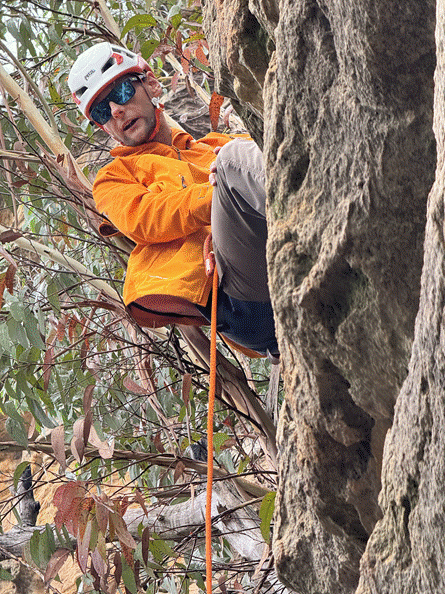
We finish a long day to a perfectly timed storm and accompanying rainbow, grab dinner outside, and make our way to Boyd River campground in the Kanangra-Boyd National Park. Kanangra is part of the Greater Blue Mountains area, and is known for its fairly untouched wilderness, some 2 hours drive beyond Mt York.

Some more photos:

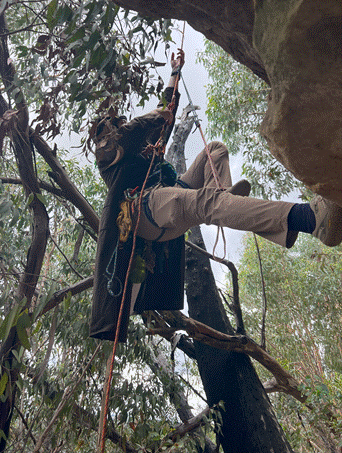

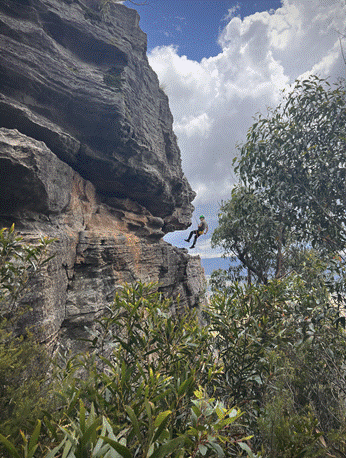
Day 3: Practicing our skills
We rose at 7 for a fairly relaxed start to the day, looking over the canyon map and sorting out enough ropes and gear so that each of us could have a turn at setting up and managing abseils. The aim of today was to practice all the skills we learnt yesterday in an actual canyon environment, and reinforce our learning.
Box Creek was picked for this activity as it is an open gorge unlike the slot canyon on Day 1, with the option to walk around the abseils if desired, and the added bonus of the warmth of the sun 🌞.

I have a go at setting up the first abseil, and it’s already a great learning experience. Learning where to thread the rope through, verifying your setup, tying all sorts of knots, verifying your setup, getting people to tie into the rope that you set up, verifying your setup - you get the idea. The first person down went to set up the next anchor, and the rest of the group slowly continued down.
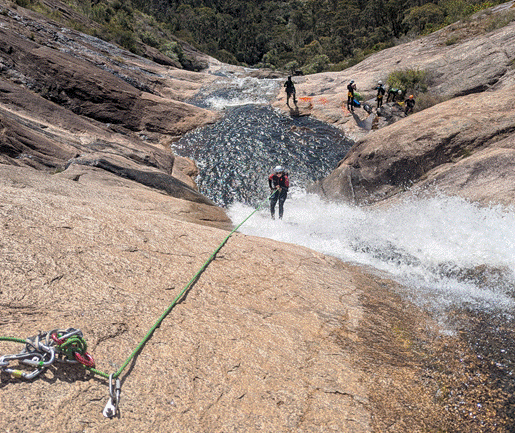
As I was the one to set the abseil up, it’s also my job to be the last one down and retrieve all of our gear. In our practice runs, the retrieval process was on dry land, standing up, with the bag in front of us.
This time was different though, we complete the abseil into a deep pool. I did not realise this until I landed in the pool. A couple of very cold and wet minutes were spent thinking how I would work around this, before realising I could just swim out of the pool onto dry land🤦🏼♀️…
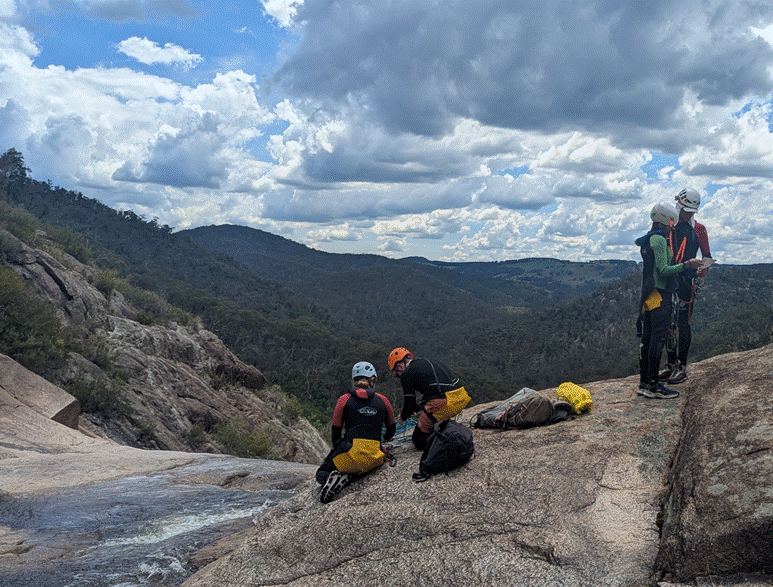
It’s 6pm by the time we reach the bottom, so we pack up our stuff and start making our way back, stopping to look at some very cool sticks, and great views.

We arrive back at the campsite around 8pm, where we start cooking a group dinner (beans and rice with a bit of spice), and discuss our plans for the next day. We are given two local canyon guidebooks and told to pick a canyon that we believe is within our skill level, as the trip leaders will be taking a backseat and it is now our job to lead the canyon, putting our skills to the test.

Despite my efforts at suggesting Carrabeanga as a great beginner canyon, we settle upon Dione Dell - one of the shorter and easier of the Kanangra canyons. The literature suggests a duration of 4-6 hours, and we estimate double that for good measure, leaving an estimated duration of 8 hours. With a desired finish time of 5pm and back in Sydney by 8pm, we decide to rise at 6:30 and start the canyon as early as reasonably possible.
We head off to sleep and around 2:30am a loud storm hits us, keeping me awake for a while, while a wombat tries to take shelter under the fly of my tent.
Day 4: Dione Dell
After the previous night’s rain the canyon is at slightly increased water levels, but nowhere near enough to be considered high flow (the average flow rate at the nearby river gauge is 150ML/d. We went in 400ML/d, and this video showcases 3500ML/d).
We plan for what gear we need, setting off at 7:30 as planned and start making our way to the canyon. The entry track is very swampy and overgrown at times, leading to several artistic interpretations of the route along the way. Once we reached the creek bed there was plenty of hands-on learning of the slipperiness of quartzite rock, which there would be no shortage of over the rest of the day. We suit up and I set up the first abseil, which is in a very awkward spot.

Our ex- trip leaders are acting as “gumbies” today, and apparently this means silly newbies in some climbing slang. I’ve never heard this word before though - the only other source I can find using this word is Scomo…
As part of these antics, Oli tried to leave his bag behind, but I managed to notice it in time. The manager of the second abseil wasn’t so lucky, and had a learning experience on how to carry down two bags filled with rope in one go 😛. (They still silently verified all our setups were safe and gave advice if we needed it)

We make our way to the bottom of the 3rd abseil where we stop to have lunch, before a 45 minute creek walk takes us to the second half of the canyon. At the top of the fourth abseil we get to learn how bad bolts look, with the ones here badly damaged and flattened right against the rock. Jason helps us set up on a tree anchor instead.
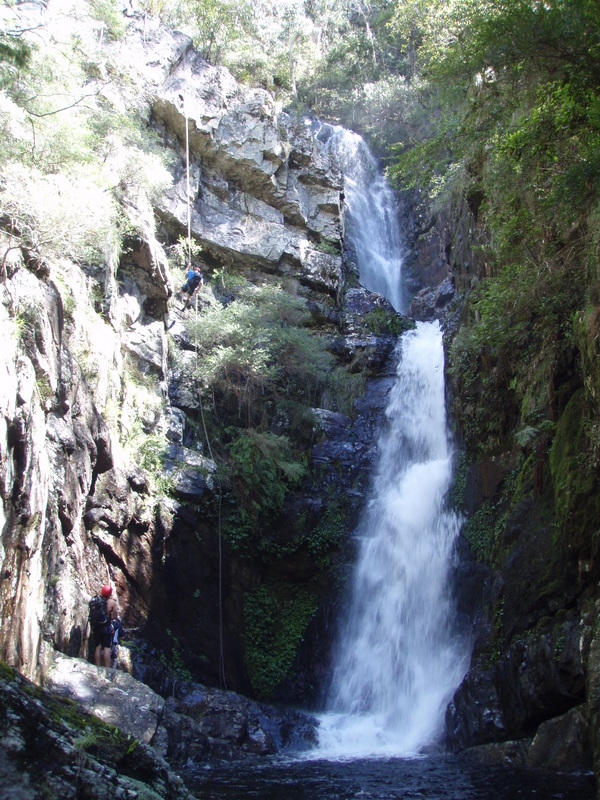
The fifth abseil is pumping quite hard with water, and almost all of us have an intimate waterboard session with the waterfall on a little ledge halfway down while we try to regain our bearings and proceed down. We didn’t take any photos of this one, but the photo from 2007 (check out our club photo archives) shows pretty much how much water there was. The only difference is we went down the waterfall, while they decided to take the dry route (lame, am I right?).
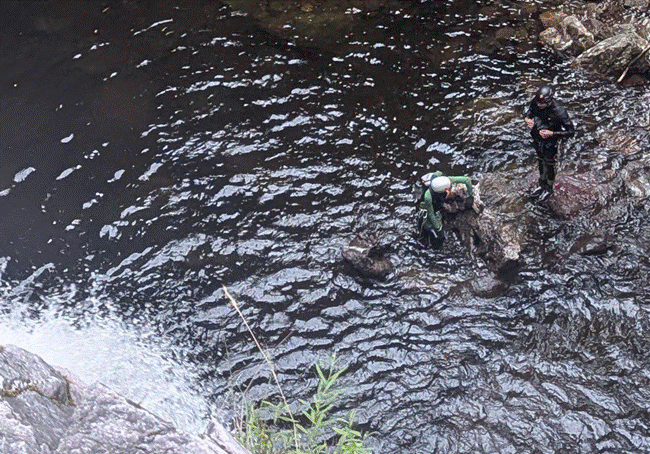
A little bit of creek walking and downclimbing takes us to the final abseil. A fun old tree stump, perfectly cut in the shape of a throne lies at the bottom of the pool, which I sit on while waiting for people to proceed down.

It is 7:30 by the time we reach the end of the canyon. Night is falling and we still have over an hour of exit track to go and to make it extra fun I forgot to pack a headtorch. Nonetheless Jason navigates us out of the canyon, up some steep terrain with no track visible at most times.

After several branches to the face, we emerge to the sweet sight of our parked cars at 9:45pm - a grand total of almost 13 hours from car to car. Despite flagrantly surpassing the time estimate, we had great fun overall. To top off the weekend, we saw a massive shooting star light up the sky at the carpark!
A great thanks to Oli and Jason for organising this training weekend, introducing us to this amazing sport, teaching us valuable skills, and tolerating us gumbies for four days.
And to the reader: I’ll see you in a canyon some day!



